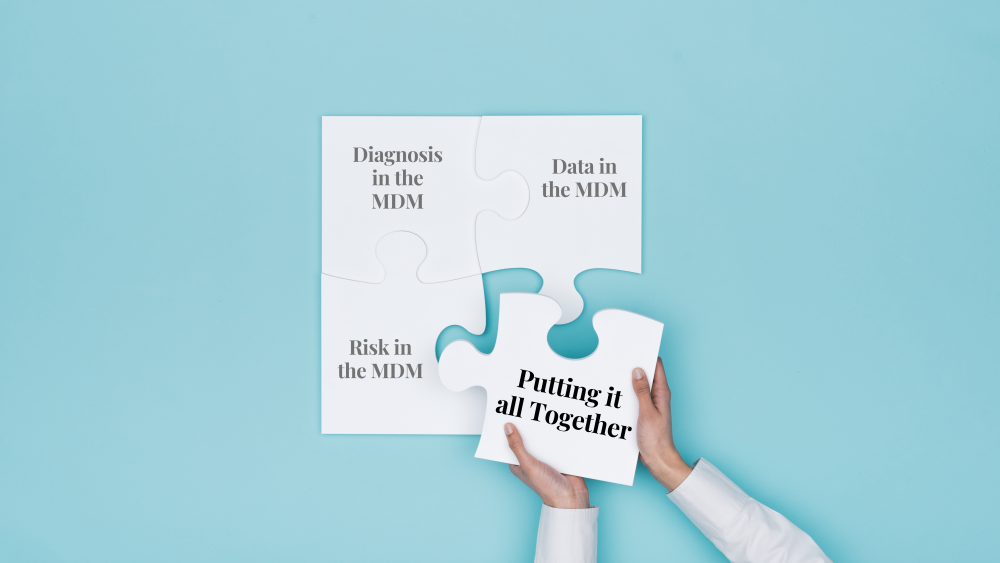
February 21, 2020 | By Pam Vanderbilt, CPC, CPMA, CPPM, CPC-I, CEMC, CEMA, CEMA-O
In the first three articles of this series, we explored how the 2021 E&M changes to office visits will affect each element of medical decision making (MDM): diagnoses, data, and the table of risk. In this article, we will put it all together and compare the way we currently score MDM to how office visits will be scored next year.
Let’s begin with an established patient who presents for six-month follow-up for diabetes. After documenting a medically appropriate history and exam, the provider states the patient’s recent A1c is within normal range and advises the patient to continue the current management. He sends a refill for Metformin to the pharmacy and plans to see him back in six months. He orders an A1c to be done one week before the return visit.
Using our current MDM scoring tool, we would assign one point for the stable chronic diagnosis, give one point for the review/ order of a lab test, and moderate on the table of risk for prescription drug management. Overall, a straightforward level of MDM would be supported.

Now let’s score the same visit using the new MDM table for 2021. The Number and Complexity of Problems Addressed meets the definition of a stable chronic illness, so supports low on the new table. The provider reviewed a unique lab test and ordered a unique test, giving us a combination of two Category 1 elements for Amount and/or Complexity of Data. This also falls into low on the new table. Finally, we have prescription drug management, so the Risk of Complications is moderate. One thing that is not changing when we score MDM is that we need two of three elements to support the level of MDM. Because we have two elements that fall into the low category, the level of MDM supported in 2021 is low.

It is easy to see with this example that how we score MDM today and how we score it in 2021 will change the outcome of many encounters. Because we will not count elements of the history and exam in 2021, using only MDM, this visit will support 99213. For those organizations that have a policy requiring MDM to be one of the two components required for an established patient visit, the 2021 changes to scoring MDM will increase the level of service reported for many visits for one chronic stable presenting problem. Today, coders and auditors in these organizations would have been limited to reporting 99212. It’s worth noting that requiring the use of MDM in determining the level of service is only supported by organizations’ own policies and arguably some best practices; it is not required by the current guidelines.
Now let’s consider a patient presenting with an acute complaint of cough, fever and sore throat for three days. We will work under the assumption there is a medically relevant history and exam documented. The provider orders a strep test which is negative, indicates the diagnosis is an upper respiratory infection and prescribes an antibiotic.
Today we would give three diagnosis points for a new problem with no additional workup. For data, one point for ordering the strep test, and the table of risk result would be moderate for prescription drug management. This would score as moderate MDM.

Using the 2021 MDM table, our problem is acute and uncomplicated, resulting in a low level for the Number and Complexity of Problems Addressed. Because we do not meet the numeric requirements for Category 1 in the data column to support low MDM and do not have documentation for Category 2, we would score the data as “Minimal or none,” equating to Straightforward. We have prescription drug management, so the Risk of Complications falls under moderate. Applying the two of three rules the MDM supported in 2021 is low, so the level of service supported for either a new or an established patient would be level three (99203 or 99213).

In both of our examples, the level of service supported (considering only MDM) changes with the new MDM table for office visits. The level of service for our chronic stable problem would increase from 99212 to 99213, and our acute uncomplicated problem decreases from level four to level three. Considering that, let’s think about the one thing we have no indication is changing: that the medical necessity of a visit is the overarching criterion to determine a level of service.
It is the opinion of this auditor that this CMS guidance points us back to how MDM is defined in the 1995 and 1997 guidelines and is not limited to how we currently credit MDM using the Marshfield tool. How we will determine the level of service based on MDM beginning next year truly seems to better align with the intent of our “outdated” guidelines and CMS’s rule about medical necessity as the overarching criterion.
As we have seen through this series, there will be some significant changes to how we score MDM for office visits. CPT has provided definitions that will help clear up some of the gray areas we have struggled with in the past, as well as introducing some new concepts (e.g. “social determinants of health”) that we will have to become familiar with. It is imperative that we begin practicing now. We can score existing E/M encounters using both our current tool and the new MDM table to help prepare us for the 2021 changes as auditors, as well as prepare us to educate our providers.
NAMAS is working diligently to provide tools to help with this transition. Stay tuned to future NAMAS e-mails to learn more.
The official AMA CPT guidance for this series can be found at https://www.ama-assn.org/system/files/2019-06/cpt-office-prolonged-svs-code-changes.pdf.









